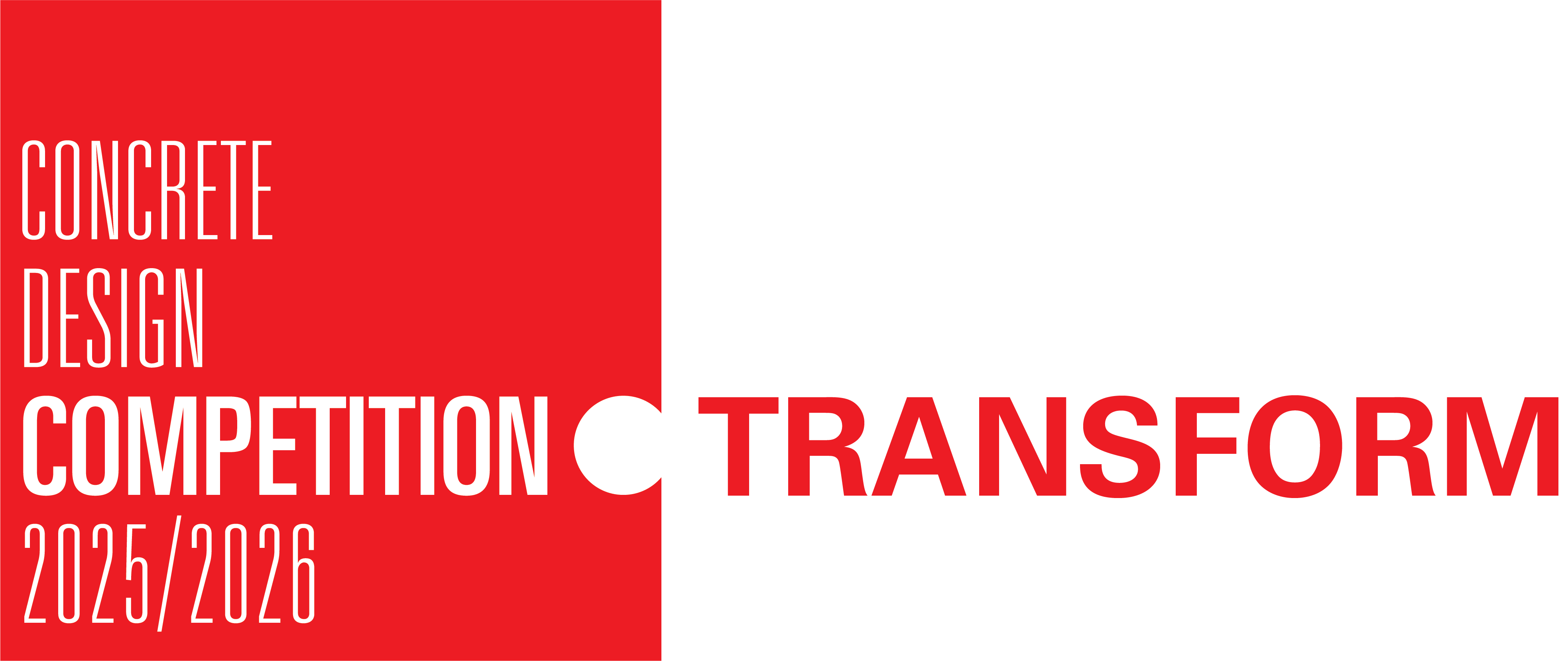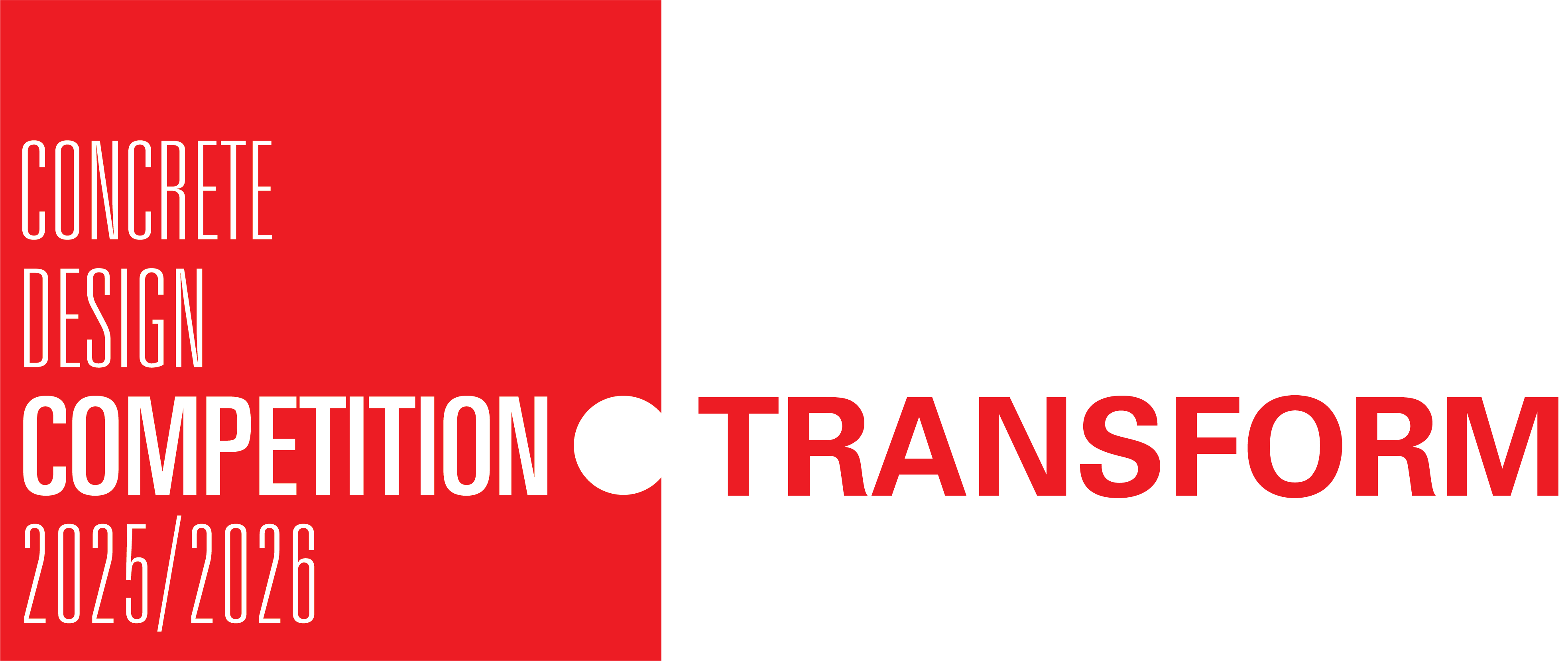In this inaugural competition students are asked to submit architectural proposals that engender ROBUSTNESS in/with/through concrete. In order to encourage the most diverse and original designs possible, no predetermined design criteria will be given or stipulated. Submissions are not limited to any scale and can range from small architectural detail, to interior, to free-standing building to landscape proposals. It is expected, however, that all proposals rigorously examine and make use of the manifest and latent qualities of concrete often hidden from view by conventional thinking and normal application. Competition entries will not be judged by stylistic, programmatic, typological, formal or other architecture design criteria, but rather according to the innovative use of concrete to achieve a high degree of design excellence.
ROBUSTNESS: ro·bust adjective [Latin, robustus, oaken, hard, strong; French, robor, robur, oak, strength; perhaps akin to the Latin, ruber, red]. 1a: Having or exhibiting strength or vigorous health: powerful, muscular, vigorous; b: firm and assured in purpose, opinion, outlook; c: exceptionally sound, flourishing; d: strongly formed or constructed, sturdy; 2: Rough, rude; 3: requiring strength or vigor; 4: Full-bodied, strong, as in coffee or wine quotation from Webster's Third International Dictionary of the English Language As indicated in the definition above, there are qualities associated with ROBUSTNESS, such as strength and solidity, which are also the qualities of concrete. Used to lay foundations, to build sturdy bridges and muscular, architectural monuments, concrete, even in its most conventional use, is an undeniably robust material. There are other qualities associated with ROBUSTNESS, however, not conventionally associated with the sturdiness of concrete. Due to the growing importance of complex, adaptive behaviour in all areas of scientific enquiry, ROBUSTNESS has also come to define the degree to which living things, whether single cell organisms, flocks of migratory birds, or complex social systems like ant colonies or metropolises like Tokyo or Mexico City, adapt to changing environmental conditions and evolve over time. ROBUSTNESS, in these contexts, defines a new kind of strength and solidity based on flexibility rather than inflexibility, on suppleness rather than stiffness, on resilience rather than rigidity, and it is this new strength that the competition seeks to explore in/with/through the use of concrete. Specifically, the competition seeks proposals that explore and exploit concrete's more conventionally robust qualities to create unconventionally robust designs whose flexibility, suppleness and resilience make them more adaptable, and therefore more durable, sustainable, hardy and long lasting.
In this inaugural competition students are asked to submit architectural proposals that engender ROBUSTNESS in/with/through concrete. In order to encourage the most diverse and original designs possible, no predetermined design criteria will be given or stipulated. Submissions are not limited to any scale and can range from small architectural detail, to interior, to free-standing building to landscape proposals. It is expected, however, that all proposals rigorously examine and make use of the manifest and latent qualities of concrete often hidden from view by conventional thinking and normal application. Competition entries will not be judged by stylistic, programmatic, typological, formal or other architecture design criteria, but rather according to the innovative use of concrete to achieve a high degree of design excellence.
Michael Speaks, curator
1ST CONCRETE DESIGN COMPETITION ON ROBUSTNESS
COMPETITION RESULTS
BA515 - Design for Public Space in St.Joost, Brussels
Belgium (national nominee)
Thomas van der Velde & Kenny Verbeeck - Vrije Universiteit Brussel
BE358 - Concrete Tech-Surface +S
Turkey - (national second prize)
Emre Çetinel - Istanbul Technical University
BX042 - The Genesis of lightweight constructions made of concrete, or: what can we do with the cement mixers?
Belgium (national nominee)
Sebastian Kreusch - Institute Supérieur d'Architecture Saint-Luc de Wallonie, Liege
CC001 - Open Source
United Kingdom (national first prize) INTERNATIONAL WINNER
Christopher Glaister, Afshin Mehin & Tomas Rosén - Royal College of Art, London
DK021 - Hazelwood Lakeside Pier
Ireland (national second prize - ex aequo) INTERNATIONAL HONOROUBALE MENTION
David Kelly - University College Dublin
EB105 - An Active Force Within
Germany (national nominee)
Daniel Zajsek - Fachhochschule Kaiserlautern
EN888 - The Wandering Stone
Netherlands (national second prize)
Bas van der Pol - Technical University Delft
FP713 - A fluid way of remembrance / an ever lasting concrete cemetery - AIDS memorial
Turkey (national first prize)
Güney Cingi, Basak Uçar & Tuba Karpuzoglu - Middle East Technical University, Ankara
MA029 - Alpine Visitor Centre / Bridge
Ireland (national first prize)
Matthew McCullagh - University College Dublin
SJ793 - Concrete As Urban Landscape
Turkey (national third prize)
Levent Firat, Onur Sariyildiz & N. Onur Sönmez - Istanbul Technical University
SM027 - Turf Shed on a Mayo Bog
Ireland (national second prize, ex aequo)
Simon Cafferty - University College Dublin
SO124 - Hangover
Netherlands (national third prize) INTERNATIONAL HONOURABLE MENTION
Niels Verkooijen - Technical University Delft
TC120 - Development of non-directional spatial skeleton structure
United Kingdom (national third prize) INTERNATIONAL WINNER
Il Hoon Roh - Royal College of Art, London
UN981 - Robust Heritage
Belgium (national nominee)
Kristof de Bonte - Vrije Universiteit Brussel
Tom Broes - Katholieke Universiteit Leuven
UW010 - Surface robustness from surface condition
United Kingdom (national second prize)
John Hutchinson & Thomas Kilvert - University of Westminster
COMPETITION JURORS
International jury
Michael Speaks, Amandus Sattler, Paul Robbrecht,
Rob Nijsse, Selahattin Onur, Alan Stanton, Derek Tynan,
Goncalo Byrne, Gert Wingard
Belgium
Wim Cuyvens, Maarten Delbeke, Pablo Lhoas, Laurent Ney, Didier Vermeiren
Germany
Klaus Bollinger, Antje Krauter, Christian Schittich,
Till Schneider, Volker Staab
Ireland
Shane O'Toole, Gary Lysaght, Antoinette O'Neill,
Taria MacGabhann
Netherlands
Koen van Velsen, Juliette Bekkering, Don Murphy,
Rene van Zuuk, Joop Paul
Portugal
Joao Luis Carrilho de Graca, Antonio Adao da Fonseca, Michael Toussaint
Sweden
Bengt Lindroos, Sten Forsstrom, Sven Ahlenius,
Carl-Eric Hagentoft, Johan Silwerbrand
Turkey
Abdi Guzer, Boran Ekinci, Emre Arolate, Ziya Tanali,
Nihal Bursa
United Kingdom
Hanif Kara, Kathryn Findlay, Sarah Chapling,
Stephen Hoddor
Concrete Design Book on ROBUSTNESS
Editor: Siebe Bakker, bureaubakker
Published by: ENCI Media, 's-Hertogenbosch, 2005
isbn: 90-71806-60-X
Participants
Kristof de Bonte, Tom Broes, Sebastian kreusch,
Thomas van der Velde, Kenny verbeeck, Sönke Gebken,
Nils Nolting, Daniel Zajsek, Marjeta Zupancic,
Simon Cafferty, David Kelly, Matthew McCullagh,
Bas van der Pol, Luc Schouten, Niels Verkooijen,
Luis Pedro Ferraz Marques, Tiago Furtado Cabeleira,
José Manuel Vacas, Markus Krunegard, Jens Laursen,
Jon Mjönes, Sebastian Nagy, Emre Cetinel, Güney Cingi,
Levent Firat, Tuba Karpuzoglu, N. Onur Sönmez,
Onur Sariyildiz, Basak Ucar, Fransesca Crosby,
Christopher Glaister, John Hutchinson, Il Hoon Roh,
Thomas Kilvert, Afshin Mehin, Tomas Rosén
Curator
Michael Speaks
Tutors
Siebe Bakker, Karl Daubmann
Critics, experts and lecturers
Jef Apers, Klaus Bollinger, Guy Chatel, Fred Gladdines,
Hans Köhne, Rob Nijsse, Wim Sambaer, Bernard Cache,
Alejandro Zaera Polo
Support
Joost Bonnema, Okke van den Broek, Matthew Louis Miller, Daniel Roos, Daan Roosegaarde, Martijn Stellingwerff, Maarten Veerman
Initiative
ATIC – Maria Dulce Louçao
BDZ – Jörg Fehlhaber
BetongForum – Öyvind Elseth, Anita Stenler
The Concrete Centre – Allan Haines
ENCI – Hans Köhne
FEBELCEM – Jef Apers
Irish Cement – Brendan Lynch
TCMA – Çaglan Becan
Photography
Okke van den Broek, Maarten Veerman
CURATOR
Michael Speaks
SCI-Arc / MR+D, Los Angeles
The role of curator is: chairman of the international jury, head of the Concrete Design Master Class and co-editor of the Concrete Design book on 'Robustness'. Michael Speaks (Ph.D., Duke University) is an educator, researcher and editor. He is currently Director of the Metropolitan Research and Design Postgraduate Program at the Southern California Institute of Architecture in Los Angeles. Speaks has taught in the graphic design department at the Yale School of Art, in the architecture departments at Harvard and Columbia Universities, and has been a researcher on the Architecture Faculty at the Technological University at Delft in the Netherlands. Speaks has published and lectured internationally on art, architecture, urban design and scenario planning, and is a contributing editor for Architectural Record as well as an editorial advisory board member of A+U (Tokyo) for which he edits the series 'Design Intelligence'.

KEY NOTE LECTURERS
Bernard Cache
Architect
Alejandro Zaera Polo
Architect

CRITICS, EXPERTS & HOSTS
Jef Apers

Klaus Bollinger
Structural civil engineer
Guy Chatel
Architect

Fred Gladdines

Hans Kohne, NL
General concrete expert
Market- and product development Cement&BetonCentrum,
host workshop - coordinator 5th Concrete Design Competition
Hans has been at the birth of the Concrete Design Competition initiative. He has appeared in various material-based workshops as consultant on all kind of concrete issues. This cycle the Netherlands operates as coordinating
country and as host for the workshop.
'It's always about connections. The meeting, the touch, there's where it happens.
This is true for people as well as for materials. It will always have my interest.'

Rob Nijsse
consulting engineer

Wim Sambaer
TUTORS
Karl Daubmann

Siebe Bakker, NL
architect / producer
Principal bureaubakker / international coordinator Concrete Design Competitions
Siebe(1964) has been a driving force behind the Concrete Design Competition since its start. He has operated as international coordinator and content provider for the competition series and its master classes.
bureaubakker produces cross-disciplinary knowledge exchanges between industries, educational institutes and design practices. We are convinced that exchange and creation of knowledge forms the key factor in understanding and developing one's own expertises. These exchanges are focused on pragmatic creative processes and are based on innovative design approaches, strategic scenario techniques, cross-cultural collaborations and decision-making methods. Firmly based on an architectural and didactical background we facilitate research and development programs ranging from brainstorm sessions to international competitions. Depending on the ambitions and expertise of our clients we offer project support starting from generating concepts and formats to full project management and coordination, marketing strategies, supervision and publications.


